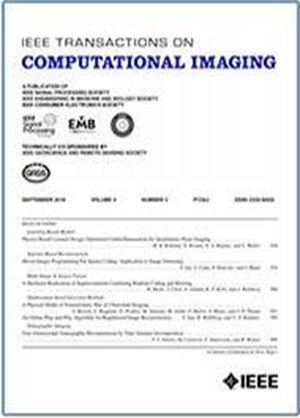基于高光谱NIR-II成像的单视点荧光分子层析成像
IF 4.8
2区 计算机科学
Q2 ENGINEERING, ELECTRICAL & ELECTRONIC
引用次数: 0
摘要
生物组织光学以其无损、高灵敏度的特性在生物医学研究中引起了广泛的关注。然而,生物组织的散射和吸收特性从根本上限制了光学成像的穿透深度。荧光分子层析成像(FMT)提供了一种平衡成像深度和分辨率的解决方案,但组织散射和吸收继续挑战深度分辨率重建的准确性。本研究开发了一种灵敏的近红外高光谱成像系统,研究荧光穿透深度与组织吸收/散射系数的关系。利用1450 nm左右的强吸水峰,我们在FMT模型中有策略地将重建对象分层,显著改善了不适定逆问题。然后,我们利用高光谱数据来选择相对于1450 nm峰吸收系数逐渐降低的波长。这使得深层生物组织的逐层三维重建成为可能,克服了传统FMT的局限性。我们的方法证明了单视角FMT重建能够分辨10 mm深度的非均匀目标,深度判别的Dice系数为0.74。这种光谱尺寸增强的FMT方法可以从单视图测量中实现精确的3D重建。通过在选定的NIR-II波长下利用与深度相关的光-组织相互作用,我们的方法在简化实验设置的同时实现了与多角度系统相当的成像质量。模拟和模拟实验都证明了精确的目标定位和形状恢复,这表明在系统复杂性和获取速度至关重要的小动物成像应用中有很大的潜力。本文章由计算机程序翻译,如有差异,请以英文原文为准。
Single-View Fluorescence Molecular Tomography Based on Hyperspectral NIR-II Imaging
Biological tissue optics has garnered significant attention in biomedical research for its non-destructive, high-sensitivity nature. However, the scattering and absorption properties of biological tissues fundamentally limit the penetration depth of optical imaging. Fluorescence molecular tomography (FMT) offers a solution balancing imaging depth and resolution, yet tissue scattering and absorption continue to challenge depth-resolved reconstruction accuracy. This study develops a sensitive near-infrared II (NIR-II) hyperspectral imaging system to investigate the relationship between fluorescence penetration depth and tissue absorption/scattering coefficients. By leveraging the strong water absorption peak around 1450 nm, we strategically divide the reconstruction object into layers within the FMT model, significantly improving the ill-posed inverse problem. We then utilize hyperspectral data to select wavelengths with progressively decreasing absorption coefficients relative to the 1450 nm peak. This enables layer-by-layer 3D reconstruction of deep biological tissues, overcoming the limitations of conventional FMT. Our method demonstrates single-perspective FMT reconstruction capable of resolving heterogeneous targets at 10 mm depth with a 0.74 Dice coefficient in depth discrimination. This spectraldimension-enhanced FMT method enables accurate 3D reconstruction from single-view measurements. By exploiting the depth-dependent light-tissue interactions at selected NIR-II wavelengths, our approach achieves imaging quality comparable to multi-angle systems while simplifying the experimental setup. Both simulation and phantom experiments demonstrate precise target localization and shape recovery, suggesting promising potential for small animal imaging applications where system complexity and acquisition speed are critical.
求助全文
通过发布文献求助,成功后即可免费获取论文全文。
去求助
来源期刊

IEEE Transactions on Computational Imaging
Mathematics-Computational Mathematics
CiteScore
8.20
自引率
7.40%
发文量
59
期刊介绍:
The IEEE Transactions on Computational Imaging will publish articles where computation plays an integral role in the image formation process. Papers will cover all areas of computational imaging ranging from fundamental theoretical methods to the latest innovative computational imaging system designs. Topics of interest will include advanced algorithms and mathematical techniques, model-based data inversion, methods for image and signal recovery from sparse and incomplete data, techniques for non-traditional sensing of image data, methods for dynamic information acquisition and extraction from imaging sensors, software and hardware for efficient computation in imaging systems, and highly novel imaging system design.
 求助内容:
求助内容: 应助结果提醒方式:
应助结果提醒方式:


